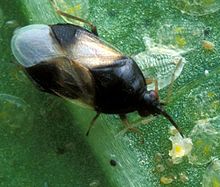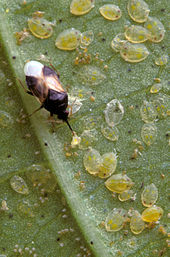- Orius insidiosus
-
Orius insidiosus 
Orius insidiosus feeding on white fly nymphs Scientific classification Kingdom: Animalia Phylum: Arthropoda Class: Insecta Order: Hemiptera Family: Anthocoridae Genus: Orius Species: O. insidiosus Binomial name Orius insidiosus
(Say, 1832)[1]Orius insidiosus, common name the insidious flower bug,[2] is a species of minute pirate bug, a predatory insect in the order Hemiptera (the true bugs). They are considered beneficial, as they feed on small pest arthropods and their eggs.[3][4] They are mass-reared for use in the biological control of thrips.[5]
Contents
Description
Orius insidiosus adults are approximately 3 mm in length. This oval-shaped insect is black with white patches on the wings.[6] Nymphs of this species are teardrop-shaped and wingless. They range from yellow-orange to brown in colour.[6]
Distribution
This species is common throughout the United States, and extends into Mexico, Central and South America. It also occurs in Cuba, Puerto Rico, and other islands of the West Indies.[7]
Life cycle
The female lays her eggs inside plant tissues, where they hatch into nymphs. Growth time from egg to mature adult takes at least 20 days. It is possible for several generations to occur during a single growing season.[7]
Diet
Orius insidiosus prey on plant-eating (phytophagous) mites and their eggs, various insect eggs, and other soft-bodied arthropods such as thrips, spider mites, and small caterpillars.[6] They also feed on the eggs and new larvae of the bollworm, spotted tobacco aphids, corn earworm, European corn borers (Ostrinia nubilalis), corn leaf aphids (Rhopalosiphum maidis), potato aphids (Macrosiphum euphorbiae), and potato leafhopper (Empoasca fabae) nymphs.[6][7]
They are used in orchards to help control the European red mite (Panonychus ulmi), the twospotted spider mite (Tetranychus urticae), and most species of aphids.[3][4] Orius insidiosus can also feed on plants and pollen.[4]
Behaviour
Both nymphs and adults feed. The adults are voracious predators and exhibit efficient searching behaviour. They congregate in areas where the density of prey is high. They are also able to propagate more rapidly in environments where prey is abundant.[4]
Orius insidiosus seizes its prey using its front legs and then inserts its long beak into its victim's body. It usually reinserts its beak several times until the soft body of the host has been emptied, leaving behind the drained exoskeleton.[6]
Orius insidiosus occasionally bites humans. Although the bite can be considered disproportionately painful relative to the size of this species, it is not harmful.[8]
Habitat
This species can be found on numerous crops, including most deciduous fruits, grapes, alfalfa, cotton, corn, and soybeans.[4]
See also
References
- ^ "Orius insidiosus (Insidious Flower Bug)". Zipcodezoo.com. http://zipcodezoo.com/Animals/O/Orius_insidiosus/. Retrieved 2010-09-14.
- ^ "insidious flower bug, Orius insidiosus (Hemiptera: Anthocoridae)". Insectimages.org. 2010-05-04. http://www.insectimages.org/browse/subthumb.cfm?sub=6847. Retrieved 2010-09-14.
- ^ a b "Minute Pirate Bugs | Iowa Insect Information Notes". Ipm.iastate.edu. http://www.ipm.iastate.edu/ipm/iiin/minutep.html. Retrieved 2010-09-15.
- ^ a b c d e "Orius". Virginiafruit.ento.vt.edu. http://www.virginiafruit.ento.vt.edu/orius.html. Retrieved 2010-09-15.
- ^ On intra-guild predation and cannibalism in Orius insidiosus and Orius laevigatus (Rhynchota Anthocoridae): laboratory experiments
- ^ a b c d e "Orius tristicolor and O. insidiosus". Cornell University. http://www.biocontrol.entomology.cornell.edu/predators/Orius.html. Retrieved 2010-09-15.
- ^ a b c "Midwest Biological Control News". Entomology.wisc.edu. http://www.entomology.wisc.edu/mbcn/kyf101.html. Retrieved 2010-09-15.
- ^ "Have a thick skin when it comes to Insidious Flower Bugs - What's Hot at the P&PDL! - Plant & Pest Diagnostic Laboratory, Purdue University". Ppdl.purdue.edu. 2010-09-02. http://www.ppdl.purdue.edu/PPDL/hot06/10-3.html. Retrieved 2010-09-15.
Further reading
- Isenhour D. J., Yeargan K. V., 1981.- Predation by Orius insidiosus on the soybean thrips, Sericothrips variabilis: effect of the prey stage and density.- Environ. Entomol. 10 (4): 496-500.
- Tavella L., Alma A., Arzone A., 1994.- Predaceus activity of Orius spp. (Anthocoridae) on Frankliniella occidentalis (Perg.) (Thripidae) on protected crops of sweet pepper.- Inf. tore Fitopat. 44 (1): 40-43.
External links
Wikimedia Foundation. 2010.

